English Flower Garden Ideas
How to create a beautiful, Blooming Romantic yard with native plants
You surprised me! Readers preferred “Blooming Romantic” (44%) and “On the Wild Side” (41%) over “American Traditional” (16%) by a landslide. You love flowers!
The favorite, “Blooming Romantic” is characterized by extensive, designed perennial flower beds defined by paths, hedges, small trees and/or walls, inspired by English country gardens. What differentiates Blooming Romantic from meadow or prairie gardens in the second most popular style, On the Wild Side, is the hardscaping and formal hedging that instill a sense of order, counterbalancing raucous flower borders.
Cole Burrell pointed out to me last week that my image for Blooming Romantic was more what he called the “blowsy, sexy” flowering side of English gardens than the “beautiful bones of fruit trees and hedges.” But it’s the all-important bones that make the Blooming Romantic style easier to pull off successfully — and more quickly — than On the Wild Side.
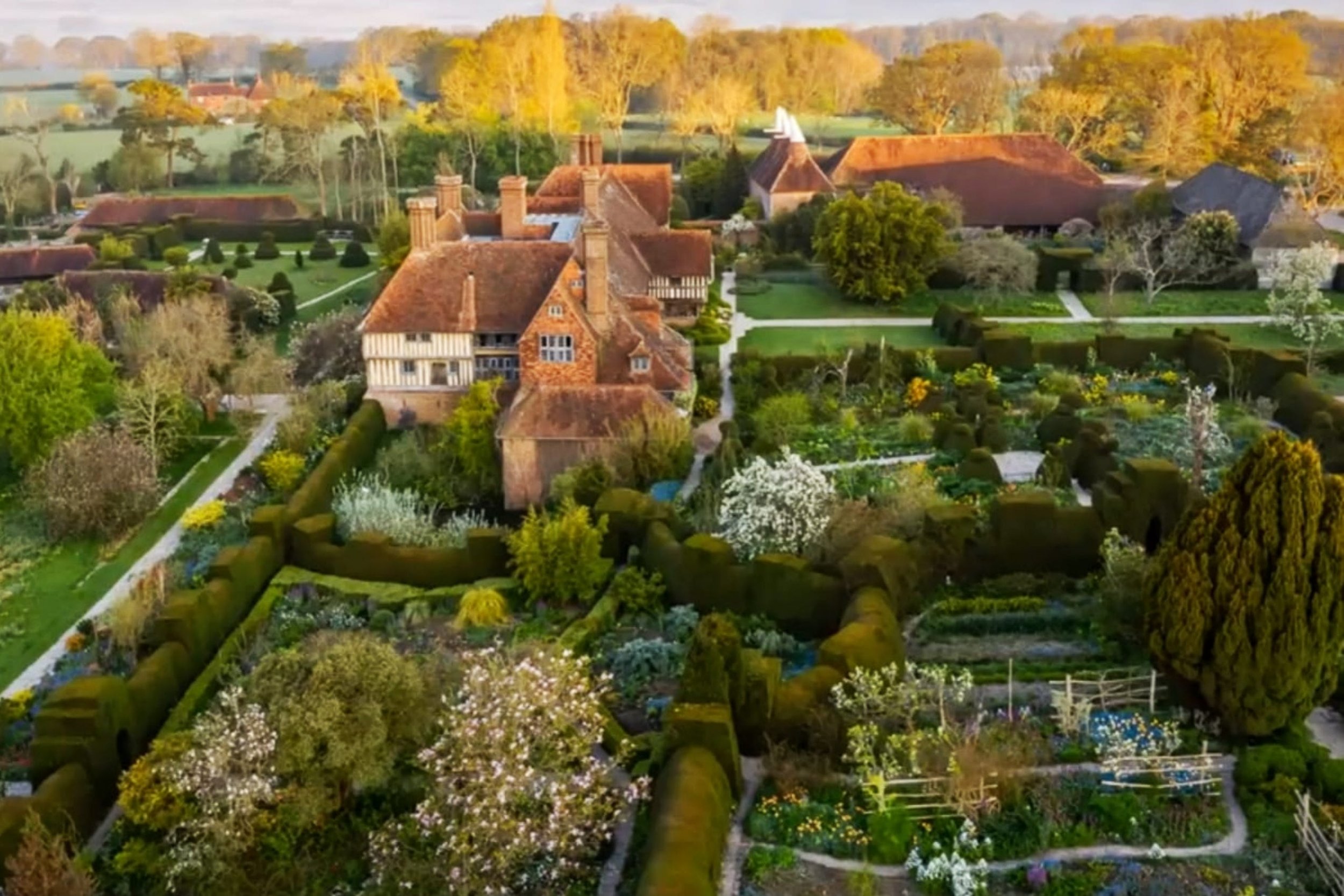
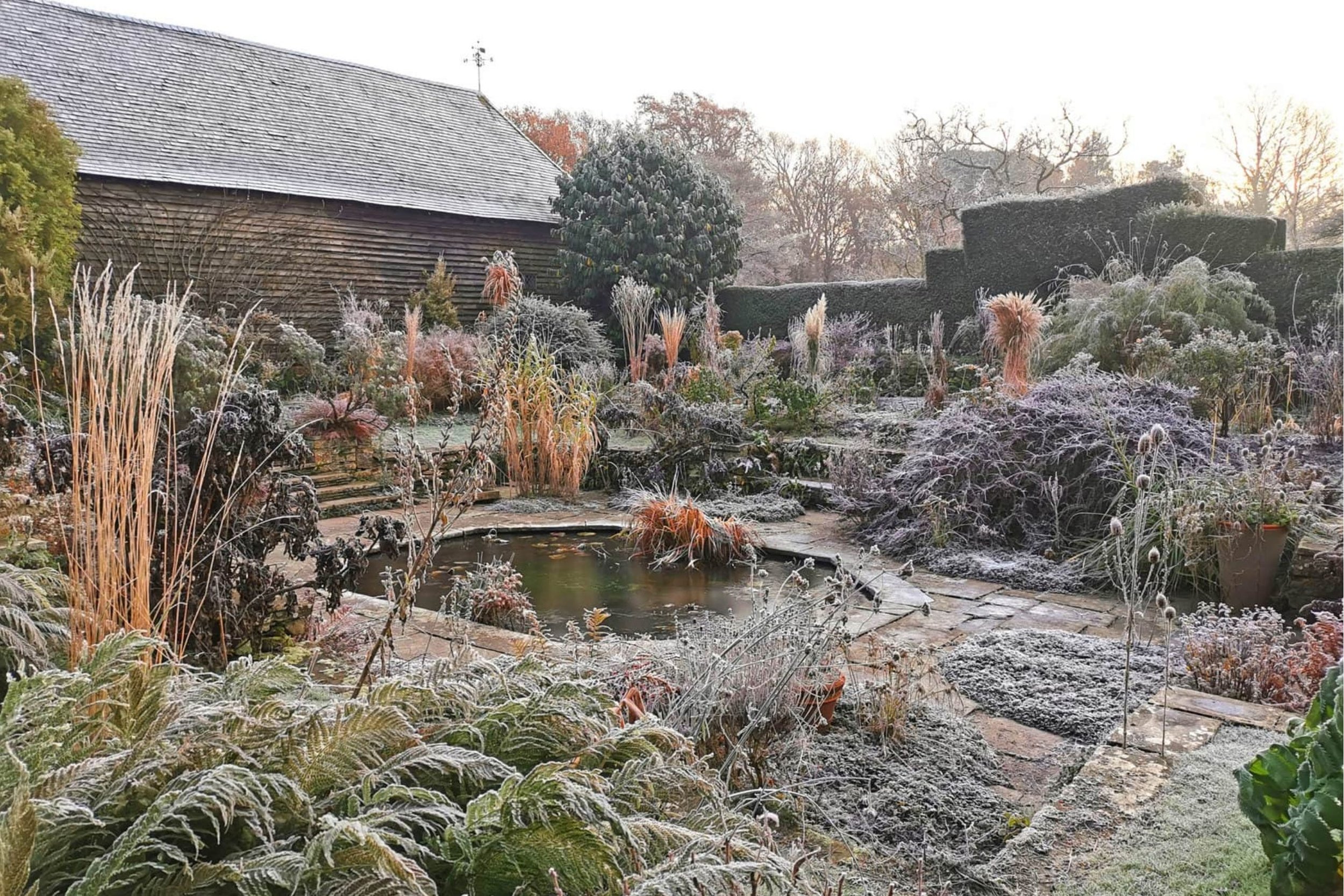
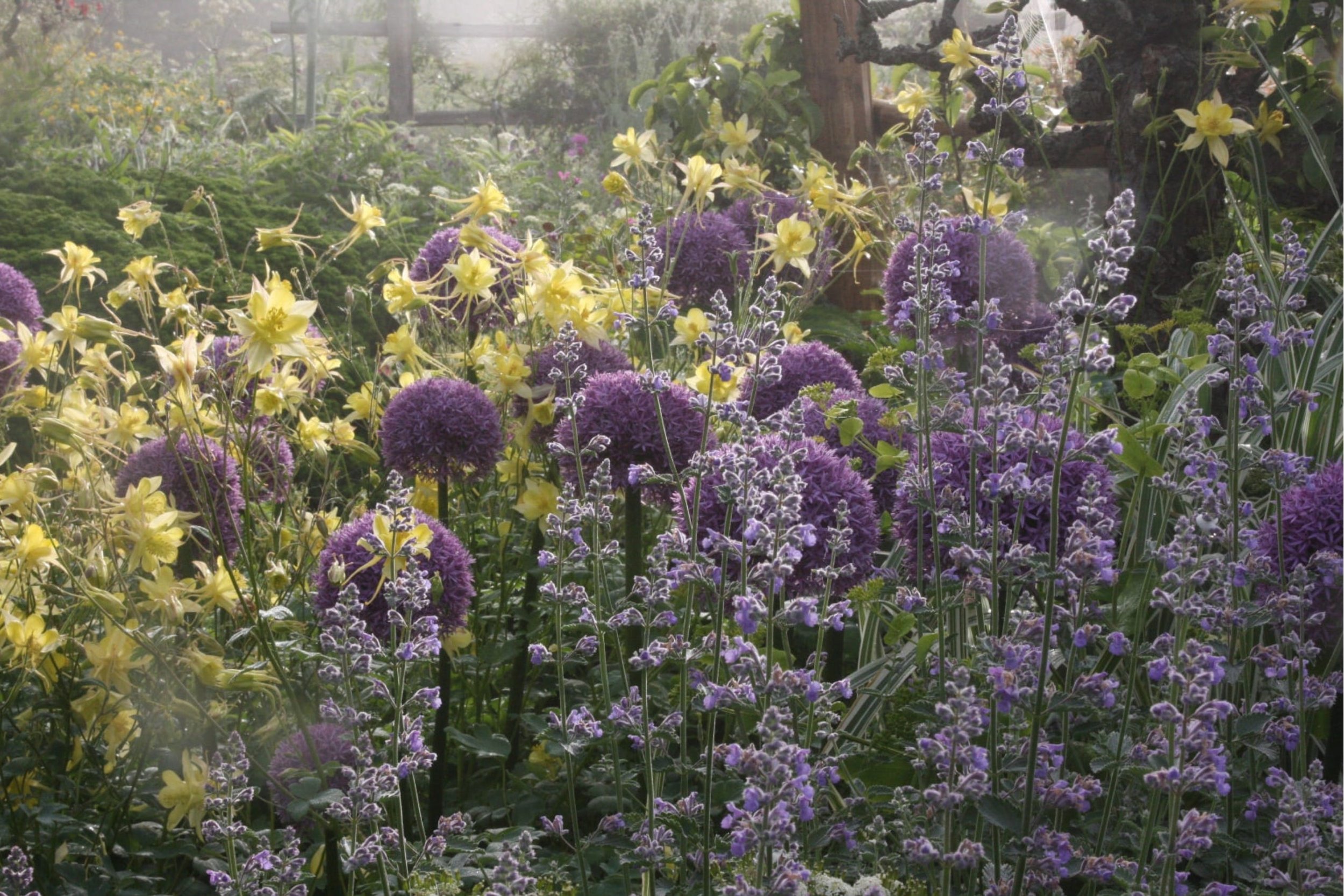
Clipped hedges frame garden rooms filled with wild plantings at Great Dixter, U.K. (source: Craftmanship)
Burrell, author of 12 gardening books, and leader of garden tours around the world (GardenandNatureTours.com), is one of several native plant experts I consulted to deliver on my promise to describe how to create your favorite style with plants native to U.S. regions.
Designed for strolling
English country (as opposed to cottage) gardens were originally designed for strolling — not lounging and certainly not playing touch football. The paths, rooms, and focal points encourage exploration and deliver frequent surprises in a relatively small area. You can spend a couple of hours or more wandering Great Dixter or Sissinghurt — and 50,000 and 200,000 visitors a year, respectively, do — all within less than six acres.
From the Tudors right up until the 18th Century formal gardens for the nobility were solely designed for walking. Needless to say, the rest of the population had absolutely no time for sitting, any gardens were practical areas for growing food for survival. — A Brief History of English Garden Furniture
Because they pack so much variety into a relatively small area, Blooming Romantic gardens are well-suited to American urban and suburban yards.
Example: Hope Alswang and Henry Joyce’s Garden
The backyard garden of Hope Alswang and Henry Joyce in Providence illustrates the effectiveness of rectangular beds outlined by symmetrical, linear paths in a small garden. Starting with a typically dismal turf yard and a rough sketch, Alswang, Joyce, and landscape designer Laura Willson created an eden within about two years.
Pea gravel paths, a steel arch, pairs of planters, a stone retaining wall, an open summer house, and existing perimeter fencing and trees provide the frame. These bones are sufficient without hedges, given the small size of the yard. The entire garden is overlooked by a deck and the back of the house, as well as the summer house.
There is no turf at all, and mostly exotic plants — though a planned entry garden will be mostly native. By the way, Alswang and Joyce’s two rambunctious dogs love playing in this formal yard. They have created a raceway along the fence, in addition to using the formal paths.
Turf can easily be incorporated into a Blooming Romantic yard. In my third-acre Rhode Island backyard, there will be a 24-foot diameter circle of turf surrounded by a large circular flower bed, cut into quadrants by grassy paths.
Blooming Romantic Garden Elements
Note all these characteristic elements of the Blooming Romantic style in the pictures below of Alswang and Joyce’s garden:
Style cues: Profusions of flowers barely contained by orderly beds; series of stylistically unique rooms connected by paths, each with a focal point; hedgerow dividers
Activities: Walking, gardening
Furniture: Stone, metal, or teak benches; pairs of planters; stone sculpture
Hardscaping: Brick or stone pavers or pea gravel patios and paths, brick walls, water features, trellises, pergolas
Plants: Hedges (often clipped) and small trees for structure; lots of flowers of various species to provide blooms throughout the season
Size: Flexible; especially good for mid-size urban to large suburban yards; in large properties, shift to naturalistic (or even wild) further from the house
Best locations: Everywhere, with looser interpretations required in the Southwest and alkaline Midwest
Work required: High — either love gardening or have plenty of money to hire trained ecological gardener
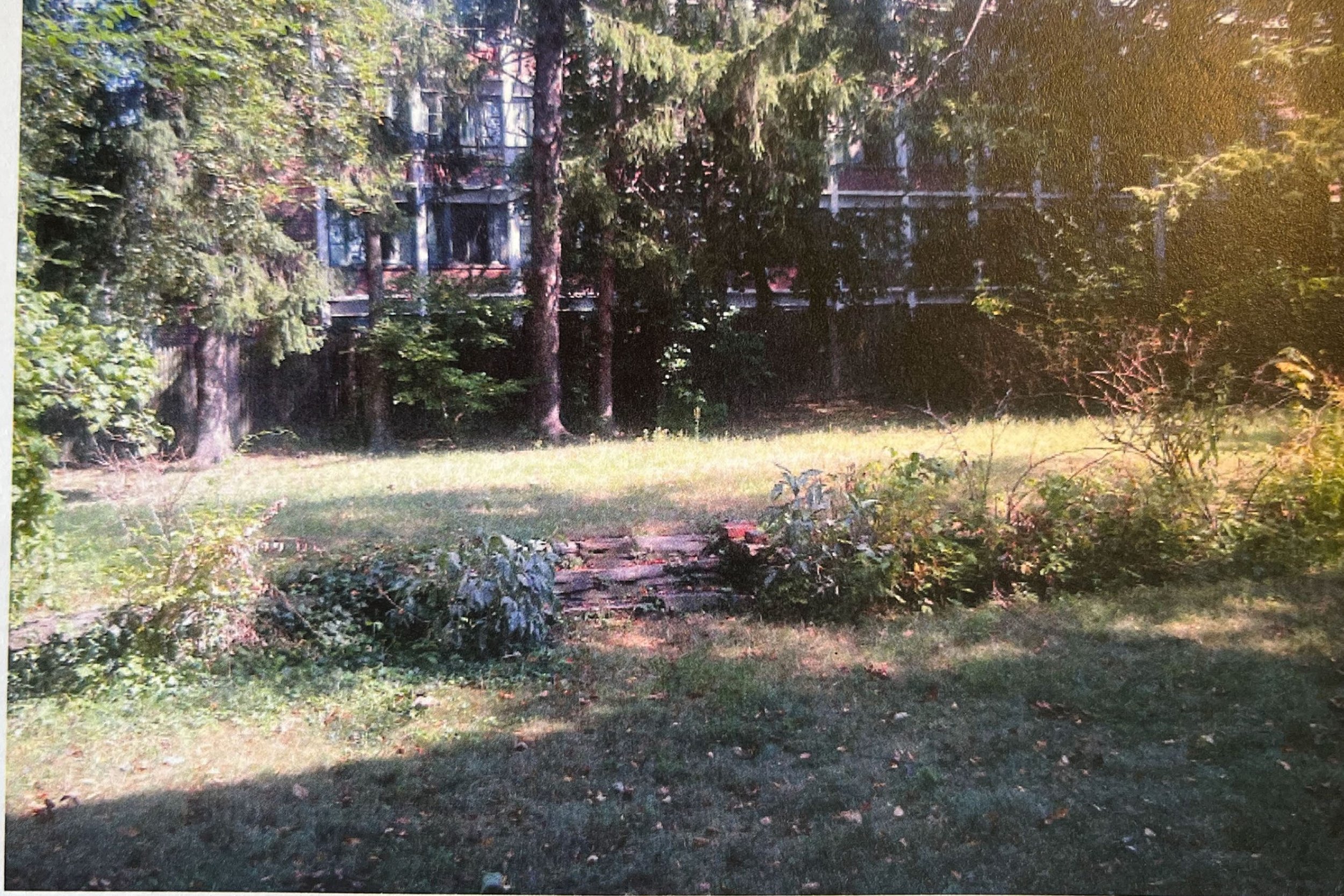
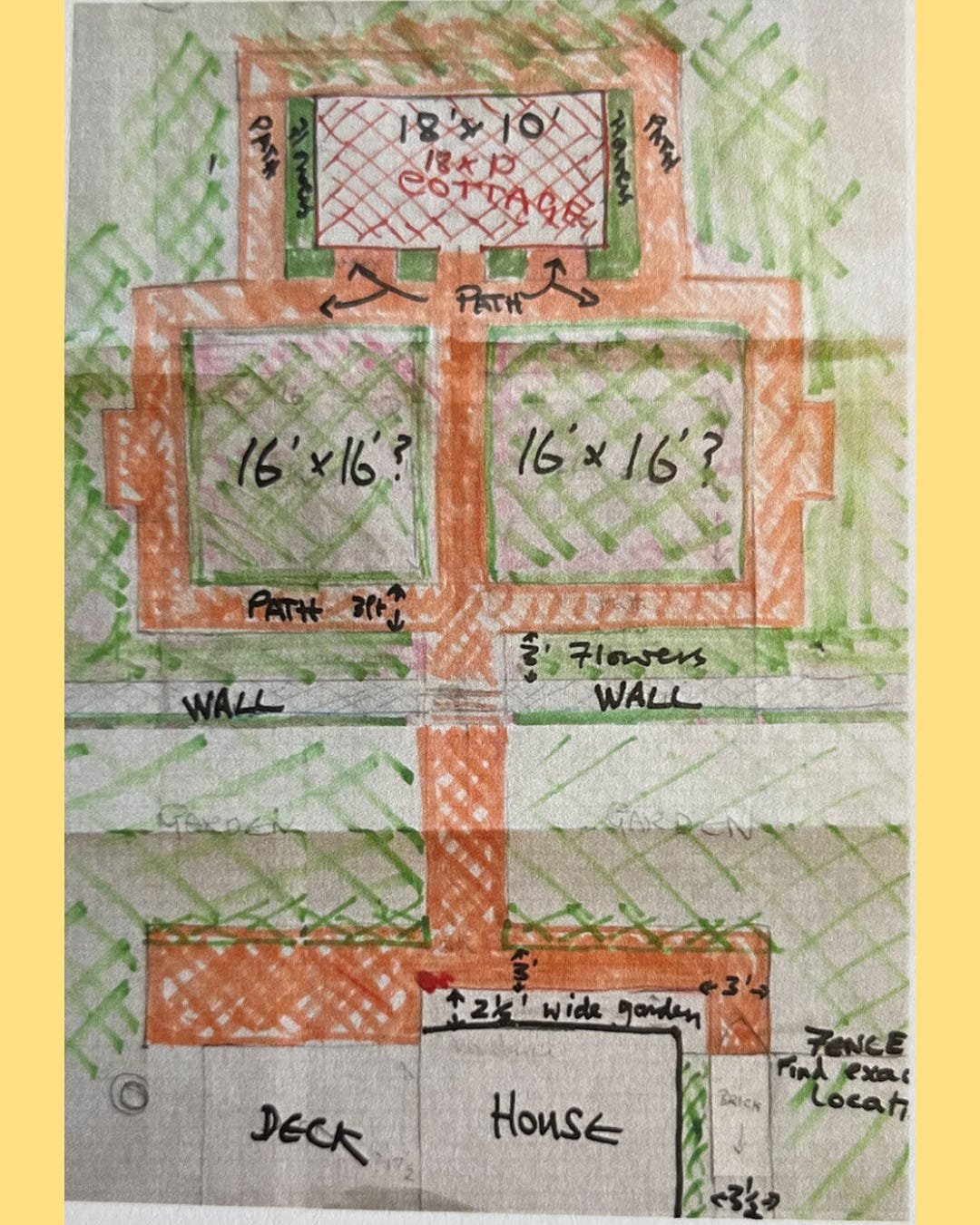
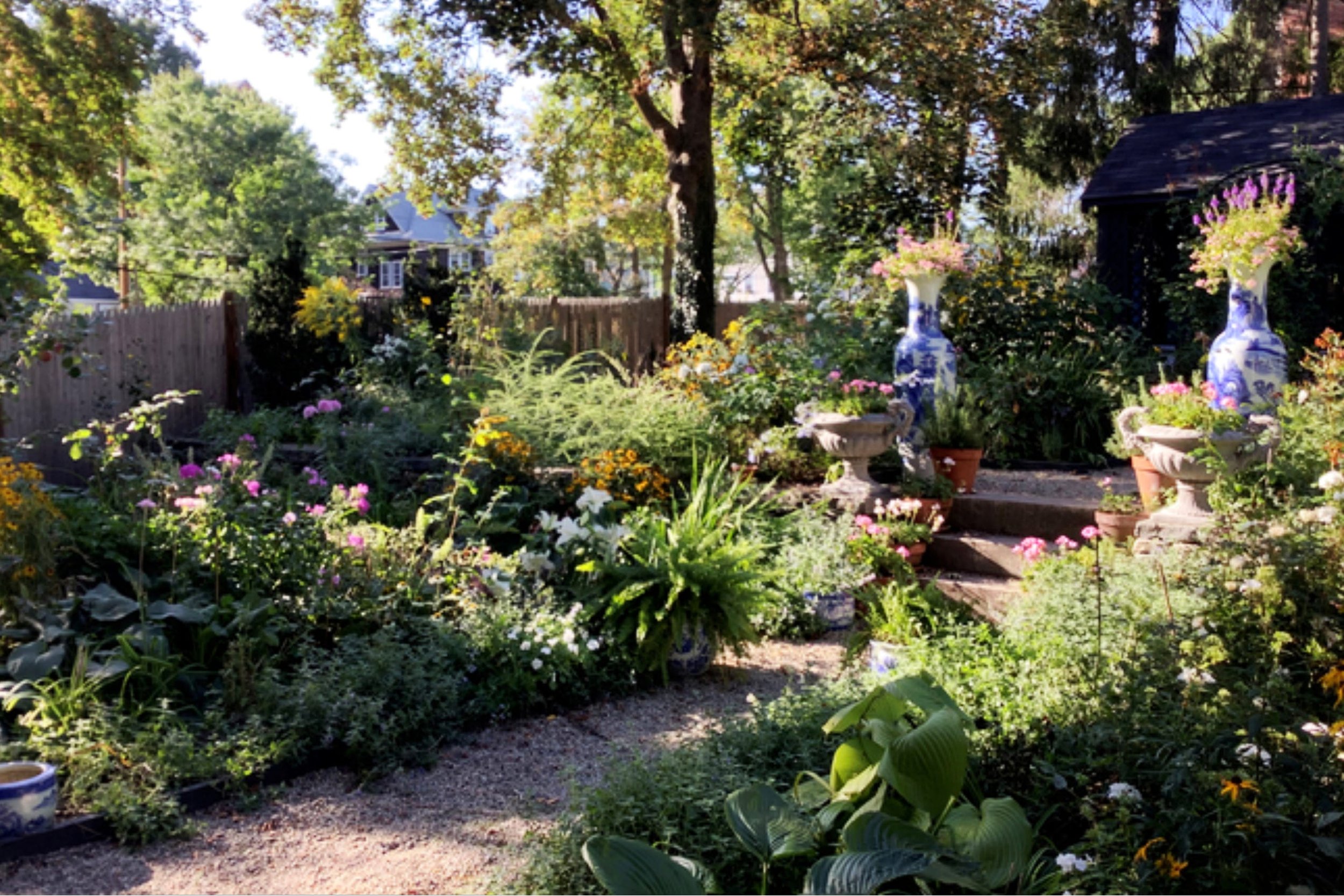
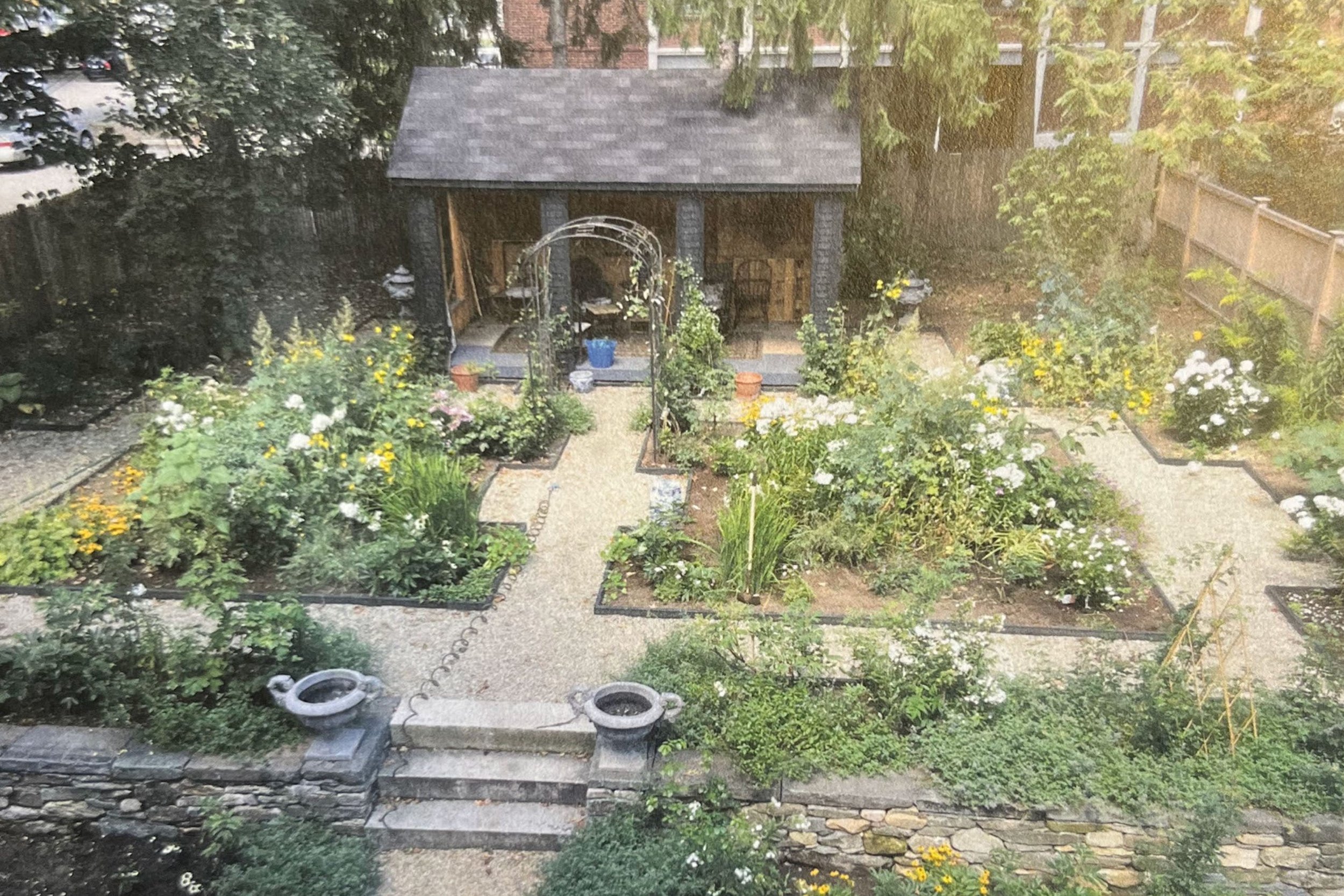
Clockwise from left: Turf yard "before," sketched plan, after a year, after three years; plants NOT native (source: Garden Conservancy)
Blooming Romantic plants for your region
As promised, here are plant suggestions for five major ecological regions within the U.S, in alphabetical order: California, East Coast, Midwest, Pacific Northwest, Southwest. These are big regions, so some plants within your region may not be native to your location — or suitable to your conditions. Before you plant, please check BONAP.org to verify whether a species is native to your county.
Note that I’m included cultivars when recommended by the experts. When I told Burrell I don’t recommend cultivars because it’s uncertain how cultivation impacts a plant species’ value to specialist insects, he cautioned that it’s difficult to maintain native shrubs at a scale that works in home gardens without employing dwarf varieties. I concur.
“The biggest challenge is the frame, which can grow too big. It’s harder than the exuberance that you can add into the frame. Remember: It’s not a restoration, it’s a garden. You have to bend the rules. If you grow natives just as they would have grown naturally, you won’t have a lot of diversity.” — Colston Burrell
Be sure to “click to continue,” if necessary, to see the plants for your region. And post a comment to let me know what you think of the Blooming Romantic style. Now, drum roll, please . . .
California
Look at the beautiful California plants recommended by Lucy Warren, co-author of The Drought-Defying California Garden!
Warren recommends you replace the following English garden plants (in bold) with these California natives:
Box: Arctostaphylos ‘Green Sphere’ (a great substitute); coffeeberry (Rhamnus californica)
English holly: Toyon (Heteromeles arbutifolia)
Italian cypress: Tecate cypress (Cupressus forbesii)
Juniper: California juniper (Juniperus californica)
Camelias: Bush anemone (Carpenteria californica)
Lilacs: California lilac (Ceanothus species and hybrids) — many choices from large tree size to groundcovers; California fuchsia (Epilobium canum) — flowers in the late summer to fall when few California plants bloom
Roses: At least seven California species with single petals, that bloom once a year, not like the highly bred garden roses. Native nootka rose (Rosa nutkana) is very similar to Asian Rosa rugosa.
English lavender: Salvia — many species and forms, groundcovers to shrubs. Salvia ‘Celestial Blue’ is a great hybrid. Desert lavender (Condea emoryi) has lavender fragrance but it is a large plant and not particularly showy.
Hollyhocks: Checker bloom (Sidalcea malviflora); farewell to spring (Clarkia amoena); hummingbird sage (Salvia spathacae)
Peonies: California peony (Paeonia californica), a shy cousin, not as flashy as hybrid peonies; I would consider the larger and more enthusiastic Matilija poppy (Romneya coulteri).
Yarrow: California yarrow (Achillea millefolium var. californica); golden yarrow (Eriophyllum confertiflorum)
Daffodils: Mariposa lily (Calochortus spp.) or lemon lily (Lilium parryi) for the yellow color (though it needs regular water).
Columbine: There are five species native to California. Red columbine (Aquilegia formosa) is red and yellow; Sierra columbine (Aquilegia pubescens) is yellow and white. Need regular water.
Foxglove: Beardtongue (Penstemon palmeri) is a great species with large spikes; Penstemon ‘Margarita BOP’ is a smaller version popular for gardens.
Pinks: Cardinal catchfly or Indian pink (Silene lacinata); annual elegant clarkia (Clarkia unguiculata)
Iris: Pacific coast iris (Iris douglasiana)
Coral bells: Multiple species of California native Heucheras
Daisy: Seaside daisy (Erigeron species); sea dahlia (Leptosyne maritima)
East Coast
Lolly Jewett, landscape designer at Bees' Knees Design and author of The Bees' Knees newsletter, recommends these East Coast natives.
Jewett recommends you replace the following English garden plants (in bold) with these East Coast natives:
Box: Inkberry holly (Ilex glabra)
English holly: American holly (Ilex opaca)
Lilacs: Pinxterbloom azalea (Rhododendron periclymenoides); American wisteria (Wisteria frutescens)
Juniper: Eastern red cedar (Juniperus virginiana)
Roses: Virginia rose (Rosa virginiana) or pasture rose (Rosa carolina)
Hollyhocks: False indigo (Baptisia australis); blazing star (Liatris spicata); swamp rose mallow (Hibiscus moscheutos)
Peonies: Blue flag iris (Iris versicolor); amsonia (Amsonia tabernaemontana)
Yarrow: Common yarrow (Achillea millefolium); blue mistflower (Conoclinium coelestinum)
Daffodils: Golden Alexander (Zizia aurea); golden groundsel (Packera aurea); Virginia bluebells (Virginia bluebells)
English lavender: Anise hyssop (Agastache foeniculum)
Camelias: Coralberry (Symphoricarpos orbiculatus)
Columbine: Wild columbine (Aquilegia canadensis); wild geranium (Geranium maculatum)
Foxglove: Tall bellflower (Campanula americana)
Pinks: Wild sweet william (Phlox divaricata); moss phlox (Phlox subulata)
Midwest
Cole Burrell recommended native Blooming Romantic plants for Midwest gardens. He cautioned that the Midwest regions encompasses both alkaline and acid soil areas.
Generally speaking, alkaline, or “basic,” soils in the U.S. are found in the Western half of the country, with the exception of the Pacific Northwest areas noted above. Here, there is much less rainfall to leach alkaline elements from the soil, and fewer trees to contribute their acidic leaves and needles to the soil. — EarthScienceGrowing.com
Burrell recommends you replace the following English garden plants (in bold) with these Midwest natives:
Box: American yew (Taxus canadensis); bog myrtle (Myrica gale); Bush honeysuckle (Diervilla lonicera)
English holly: Viking black chokeberry (Aronia melanocarpa)
Juniper: Grey owl juniper (Juniperus virginiana 'Grey Owl')
Lilacs: New Jersey tea; Robinia hispida; Sambucus racemosa
Roses: Prairie rose (Rosa setigera)
English lavender: Leadplant (Amorpha canescens)
Hollyhocks: Scarlet rosemallow (Hibiscus laevis); rose mallow (Hibiscus moscheutos subsp. palustris)
Peonies: Smooth phlox (Phlox glaberrima); prairie phlox (Phlox pilosa)
Yarrow: Common yarrow (Achillea millefolium)
Daffodils: Golden Alexanders (Zizia aurea); wood lily (Lilium philadelphicum)
Camelias: Prairie onion (Allium stellatum)
Columbine: Red columbine (Aquilegia canadensis)
Foxglove: Prairie larkspur (Delphinium carolinianum); blazing stars (various, e.g., Liatris punctata); hoary vervain (Verbena stricta); wild indigos (Baptisias – e.g., alba, bracteata)
Pinks: White gaura (Oenothera lindheimeri); prairie verbena (Glandularia bipinnatifida); moss phlox (Phlox subulata); sand phlox (Phlox bifida)
Pacific Northwest
Sami Gray is a botanist, former native plant nursery owner, and co-author of the upcoming Weeds of the Pacific Northwest (Timber Press). She cautions:
The Pacific Northwest covers a huge range of climates and soil types, and not all natives will be happy in all areas of the region, though adjustments can be made (e.g., providing “sharp drainage” for . . . west side rainfall). It pays to research. — Sami Gray
For less familiar plants, Gray recommends searching the image collection at Burke Herbarium.
Gray recommends you replace the following English garden plants (in bold) with these Pacific Northwest natives:
Box: Evergreen huckleberry (Vaccinium ovatum)
Holly: California wax myrtle (Morella californica); holly-leaved Oregon grape (Mahonia aquifolium)
Lilac: Several California lilac species (Ceanothus spp.)
Juniper: Four native junipers (Juniperus spp.)
Rose: Clustered rose (Rosa pisocarpa) and Nootka rose (Rosa nutkana) are quite large; a smaller shrub, baldhip rose (Rosa gymnocarpa), is surprisingly shade-tolerant
Hollyhocks: Orange globe mallow (Sphaeralcea coccinea); Sidalceas — several very showy herbaceous species, east and west sides; streambank wild hollyhock (Iliamna rivularis)
Peonies: Subalpine spirea (Spiraea splendens); western bog laurel (Kalmia microphylla)
Yarrow: Common yarrow (Achillea millefolium)
Daffodils: Glacier lily (Erythronium grandiflorum); yellow bells (Fritillaria pudica); common camas (Camassia quamash); nodding wild onion (Allium cernuum)
Iris: Numerous native species, mostly a foot or so tall, white, yellow, purple
English lavender: Purple sage (Salvia dorrii); western giant hyssop (Agastache occidentalis); mountain monardella (Monardella odoratissima);
Camellia: Several species of Ribes, including blood currant (Ribes sanguineum); California sweet shrub (Calycanthus occidentalis); mock orange (Philadelphus lewisii)
Columbine: Yellow columbine (Aquilegia flavescens) on the east side and western columbine (Aquilegia formosa) on the west side
Foxglove: The plant most people here think of as "foxglove" is Digitalis purpurea, which is widely naturalized (a polite word meaning "It's such a successful weed that we give up"); it is NOT native. Better choices for tall perennials in part shade would include the native species within the genera Thalictrum, Corydalis, Aruncus and Cimicifuga.
Pinks: Silenes (S. hookeri, acaulis, laciniata — pink to red, showy, drought loving, low-growing; S. campanulata and S. lemmonii — also dry-loving white flowers); field chickweed (Cerastium arvense)
Southwest
Noelle Johnson, known as AZ Plant Lady, is a teacher, landscape designer, and author of several garden books, including the popular Dry Climate Gardening. Regarding the Blooming Romantic style, she notes:
Most native SW shrubs aren’t well suited for formal pruning. I’ve recommended some with a lovely natural shape, plus favorite natives for a cottage garden look in the desert. — Noelle Johnson
Johnson recommends you replace English shrubs with these Southwest natives:
Texas sage (Leucophyllum frutescens)
Jojoba (Simmondsia chinesis)
Baja ruellia (Ruellia peninsularis) — native to Baja California, Mexico
Chuparosa (Justicia californica)
Woolly butterfly bush (Buddleja marrubiifolia)
Johnson recommends you replace English flowers with these Southwest natives:
Desert marigold (Baileya multiradiata)
Globe mallow (Sphaeralcea ambigua)
Goodding's verbena (Glandularia gooddingii)
Mexican evening primrose (Oenothera speciosa)
Autumn sage (Salvia greggii) — native to west and south Texas
Blackfoot daisy (Melampodium leucanthum)
Parry's penstemon (Penstemon parryi)
Firecracker penstemon (Penstemon eatonii)
Pink Fairy Duster (Calliandra eriophylla)






